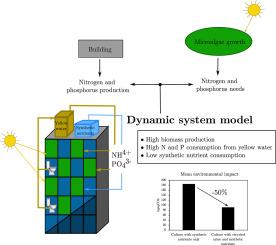从黄水中回收氮和磷,为建筑立面提供微藻培养的模型系统
IF 10
1区 环境科学与生态学
Q1 ENGINEERING, ENVIRONMENTAL
引用次数: 0
摘要
微藻生物立面的主要目的之一是通过在建筑和安装在其立面上的微藻培养系统之间交换物质和能量来提高建筑的可持续性。本研究评估了处理建筑物中的黄水(即来源分离的尿液)的潜力,作为从微藻中生产生物质的生物立面概念的额外好处。为了限制对整体生物量生产力的影响,只有部分生物立面用于尿液处理:尿液供应给一些pbr,而合成营养素供应给其他pbr。这种化学循环有可能减少微藻培养过程对环境的影响,因为它减少了铵和磷酸盐的使用,也有可能减少建筑本身对尿液的影响,因为它在作为废水排放之前进行了回收,以便进一步处理。然而,评估和优化这一过程并不简单,因为藻类的生长与养分和光照的可用性以及净化效率密切相关。本研究的目的是通过模拟确定该系统的最佳运行参数:黄水稀释率(dWW)和培养物的水力保留时间(HRT),以最大限度地提高尿液供应的生物立面比例、净化效率和生物质生产力,同时考虑到昼夜周期和尿液产生曲线等相关参数的动态变化。结果表明,通过使运行参数(dWW和HRT)适应建筑物的位置和季节,该系统可以利用约50%的生物立面回收产生的所有尿液,从而增加了微藻生物立面实现建筑物黄水回收解决方案的潜力。在这个过程中,黄水中90%以上的氮和磷被微藻消耗,尽管总体生物量生产能力降低了40%。因此,使用黄水作为营养物质的来源有可能减少生物质生产的环境足迹,与完全由合成营养物质提供的生物立面相比,二氧化碳排放量减少50%。本文章由计算机程序翻译,如有差异,请以英文原文为准。

Model system for recovering nitrogen and phosphorus from yellow water to supply a microalgae culture on a building facade
One of the main aims of microalgae biofacades is to improve the sustainability of buildings by exchanging matter and energy between the building and the microalgae culture system installed on its facade. This study evaluates the potential for treating the yellow water from buildings (i.e. source-separated urine) as an added benefit to the biofacade concept of producing biomass from microalgae. To limit the impact on overall biomass productivity, only part of the biofacade was used for the urine treatment: urine was supplied to some of the PBRs while synthetic nutrients were supplied to the others. This chemical loop has the potential to reduce the environmental impact of both the microalgae culture process, by reducing the use of ammonium and phosphate salts, and the building itself, by recovering the urine before it is discharged as wastewater for further treatment.
However, evaluating and optimizing the process is not straightforward because algae growth is closely linked with nutrient and light availability and purification efficiency. The objective of this study is to ascertain the optimal operating parameters for the system: the yellow water dilution rate (dWW) and hydraulic retention time (HRT) of the culture through simulation, to maximize the proportion of the biofacade supplied with urine, the purification efficiency, and the biomass productivity, taking into account the dynamics of relevant parameters such as day–night cycles and urine production profile. The results reveal that by adapting the operating parameters (dWW and HRT) to the location of the building and the season, the system can recycle all the urine produced using about 50% of the biofacade, thus increasing the potential of microalgae biofacades to achieve yellow water recycling solution for buildings. With this process, over 90% of the nitrogen and phosphorus in yellow water is consumed by the microalgae, although the overall biomass production capacity is reduced by 40%. Using yellow water as a source of nutrients therefore has potential for reducing the environmental footprint of biomass production, with 50% less emissions than biofacades supplied entirely with synthetic nutrients.
求助全文
通过发布文献求助,成功后即可免费获取论文全文。
去求助
来源期刊

Journal of Cleaner Production
环境科学-工程:环境
CiteScore
20.40
自引率
9.00%
发文量
4720
审稿时长
111 days
期刊介绍:
The Journal of Cleaner Production is an international, transdisciplinary journal that addresses and discusses theoretical and practical Cleaner Production, Environmental, and Sustainability issues. It aims to help societies become more sustainable by focusing on the concept of 'Cleaner Production', which aims at preventing waste production and increasing efficiencies in energy, water, resources, and human capital use. The journal serves as a platform for corporations, governments, education institutions, regions, and societies to engage in discussions and research related to Cleaner Production, environmental, and sustainability practices.
 求助内容:
求助内容: 应助结果提醒方式:
应助结果提醒方式:


